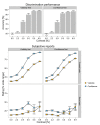Visibility Is Not Equivalent to Confidence in a Low Contrast Orientation Discrimination Task
- PMID: 27242566
- PMCID: PMC4874366
- DOI: 10.3389/fpsyg.2016.00591
Visibility Is Not Equivalent to Confidence in a Low Contrast Orientation Discrimination Task
Abstract
In several visual tasks, participants report that they feel confident about discrimination responses at a level of stimulation at which they would report not seeing the stimulus. How general and reliable is this effect? We compared subjective reports of discrimination confidence and subjective reports of visibility in an orientation discrimination task with varying stimulus contrast. Participants applied more liberal criteria for subjective reports of discrimination confidence than for visibility. While reports of discrimination confidence were more efficient in predicting trial accuracy than reports of visibility, only reports of visibility but not confidence were associated with stimulus contrast in incorrect trials. It is argued that the distinction between discrimination confidence and visibility can be reconciled with both the partial awareness hypothesis and higher order thought theory. We suggest that consciousness research would benefit from differentiating between subjective reports of visibility and confidence.
Keywords: confidence; consciousness; metacognition; signal detection theory; visibility; visual awareness.
Figures






Similar articles
-
Modelling visibility judgments using models of decision confidence.Atten Percept Psychophys. 2021 Nov;83(8):3311-3336. doi: 10.3758/s13414-021-02284-3. Epub 2021 Jun 4. Atten Percept Psychophys. 2021. PMID: 34089166 Free PMC article.
-
Being confident without seeing: what subjective measures of visual consciousness are about.Atten Percept Psychophys. 2013 Oct;75(7):1406-26. doi: 10.3758/s13414-013-0505-2. Atten Percept Psychophys. 2013. PMID: 23868563
-
Metacognitive sensitivity of subjective reports of decisional confidence and visual experience.Conscious Cogn. 2015 Sep;35:192-205. doi: 10.1016/j.concog.2015.02.011. Epub 2015 Mar 7. Conscious Cogn. 2015. PMID: 25758187
-
Confidence in masked orientation judgments is informed by both evidence and visibility.Atten Percept Psychophys. 2018 Jan;80(1):134-154. doi: 10.3758/s13414-017-1431-5. Atten Percept Psychophys. 2018. PMID: 29043657
-
Consciousness and confidence.Neuropsychologia. 2019 May;128:255-265. doi: 10.1016/j.neuropsychologia.2018.01.018. Epub 2018 Feb 3. Neuropsychologia. 2019. PMID: 29355646 Review.
Cited by
-
The Relation Between Subjective and Objective Measures of Visual Awareness: Current Evidence, Attempt of a Synthesis and Future Research Directions.J Cogn. 2024 Jul 18;7(1):59. doi: 10.5334/joc.381. eCollection 2024. J Cogn. 2024. PMID: 39035071 Free PMC article.
-
The Perceptual Awareness Scale-recent controversies and debates.Neurosci Conscious. 2021 Dec 15;2021(1):niab044. doi: 10.1093/nc/niab044. eCollection 2021. Neurosci Conscious. 2021. PMID: 34925909 Free PMC article.
-
Prestimulus EEG Power Predicts Conscious Awareness But Not Objective Visual Performance.eNeuro. 2017 Dec 12;4(6):ENEURO.0182-17.2017. doi: 10.1523/ENEURO.0182-17.2017. eCollection 2017 Nov-Dec. eNeuro. 2017. PMID: 29255794 Free PMC article.
-
Temporal attention causes systematic biases in visual confidence.Sci Rep. 2019 Aug 12;9(1):11622. doi: 10.1038/s41598-019-48063-x. Sci Rep. 2019. PMID: 31406265 Free PMC article.
-
Dissociating the Neural Correlates of Subjective Visibility from Those of Decision Confidence.J Neurosci. 2022 Mar 23;42(12):2562-2569. doi: 10.1523/JNEUROSCI.1220-21.2022. Epub 2022 Feb 4. J Neurosci. 2022. PMID: 35121637 Free PMC article.
References
-
- Barton K. (2014). MuMIn: Multi-Model Inference. R Package Version 1.10.5. Available at: http://cran.r-project.org/package=MuMIn
LinkOut - more resources
Full Text Sources
Other Literature Sources

